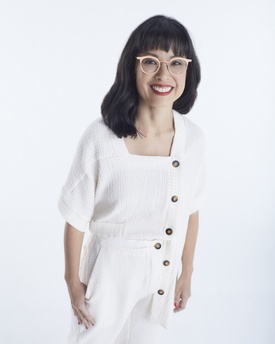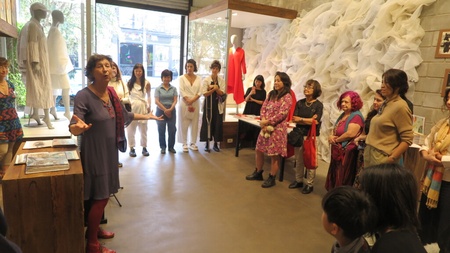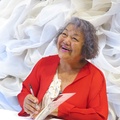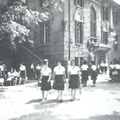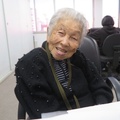Creating works that reflect the Brazilian soil
When Akiko landed at the port of Santos, she recalled as if it had happened just recently, "I felt as if I was being held up by my mother. I wonder if it could be called the preciousness of the earth. I felt so happy, so happy, like I was being held by something so big." Creating ceramic works using fragments of that "earth" was also a way of giving form to that feeling.
"When I create my work, I always feel the power of the earth. Brazil has that. I felt that and put it into my work."
He built a climbing kiln in Cotia and, using a manual lathe, clay that is part of the earth, and glazes made from leaves, produced a series of works that influenced the local art scene. His works, which are spherical, cylindrical, egg-shaped, and other shapes that are far from practical, are considered contemporary works of art in the region, as if they express the feeling of being in the womb of the Brazilian earth.
"I didn't want to make pretty pottery. I wanted to create works that had depth rather than just external beauty. I continued making pottery, and when I turned 90, I finally became convinced that I had found it. So I thought it was time to quit. From now on I had to head towards the sky, which means towards God. I thought it was okay if God called me. I'm neither Buddhist nor Christian. I created my own relationship with God in my heart. This is not a religion."
After reaching this state of mind, he suffered a stroke.
Yuba Isamu saw the "primitive forest" and was filled with the excitement of creating an immigrant culture there, and created a new agricultural community. Akiko "felt a special power in the Brazilian soil, and put it into her ceramic works." Indeed, one was strongly inspired by this place and this land, and one took the form of a communal farm, while the other sublimated it into a work of pottery. As Katsushige says, there may be some similarities.
SPFW designers enthralled by Yuba
When we asked Fernanda Yamamoto (44, fourth-generation Japanese, from São Paulo), the designer who provided the venue for this event, about her connection with Yuba Farm, she said that she had become acquainted with Silvia Osaka, who had lived on the farm for about 20 years, and was invited to spend a few days on the farm about 15 years ago.
"It was a very interesting space. I've always been interested in Japanese kimonos and tie-dyeing techniques, and have been researching how to apply them to my own fashion, so it was interesting, like looking at a living sample," she recalls.
Fernanda's great-grandparents were from Hiroshima Prefecture and emigrated there around 1920. They settled in areas along the Paulista Line, such as Marilia and Bastos, and worked as farmers, and her parents moved to São Paulo after the war and made a living as feirantes. This is where a famous designer who is active at São Paulo Fashion Week was born.
He majored in business administration at university, but became interested in fashion while working in a sewing factory, and re-studied at Parsons School of Design in New York. He decided to become a designer because he was "inspired by and influenced by Yohji Yamamoto, Rei Kawakubo, and Issey Miyake," and opened his current store (Rua Aspicuelta, 441) 15 years ago.
He has been to Japan five times. Two of those times were for Japan Fashion Week (JFW), and the last time in 2010, he was selected as one of three designers for JFW's new talent discovery project "Shinmai." He was supposed to show at the 12th JFW as an up-and-coming designer in March 2011. "But then the Great East Japan Earthquake happened and the show was cancelled. It's really unfortunate. Even now, it's my dream to show in Japan," he said, regretting it.
Fernanda has a close relationship with the farm, having twice presented collections themed around the farm at Sao Paulo Fashion Week (SPFW). "I love Japanese food, and Japanese culture is a source of inspiration for my designs," she said.
A story of three women in the arts
On the day, writer and researcher Giulia Pascali, a friend of Katsushige's for 40 years, also visited the venue and praised him, saying, "Katsushige never graduated from university, but he is a true philosopher of life.He has conducted repeated experiments in life to make agriculture and art coexist, and has written books about the results."
Pascali also wrote the foreword to "The Glorious Pioneer," in which he writes about Katsushige:
"In today's world, where everything is disposable and speed is the supreme priority, traditional knowledge and ways of life have taken a back seat. In such fleeting times, the wise and powerful voice of tradition can be heard in this book. Katsue Yuba is an artist who sings, cooks, paints, and makes clothes. She has used her diverse talents of expression to capture in her paintings and writings the knowledge and lifestyles of Japanese immigrants who came to Brazil with dreams, hope and light," he analyzed from a Brazilian perspective.
Katsushige emphasized, "What my father says and what Akiko says have something in common. There are also things in common with Fernanda. That's why it's meaningful to hold the publication event for Akiko's book, which I wrote, here in this store. We are able to be as successful as we are because of the foundation of Japanese immigration. It is a fact that Japanese people have lived their lives with love. I want people around the world to know this. That is God's plan."
This mysterious place was born from the gathering of three strong women: Katsushige Yuba, who was born and raised in the unique community farming environment; Akiko Suzuki, who left Japan to create her own ceramics in South America; and Fernanda Yamamoto, an up-and-coming artist active at SPFW. I felt that this event symbolized the contributions of Japanese women to Brazilian society that are both old and new, traditional and avant-garde.
*This article is reprinted from the Brazil Nippo (August 22, 2023).
© 2023 Masayuki Fukasawa


